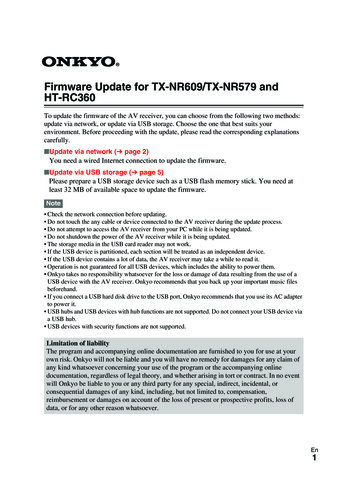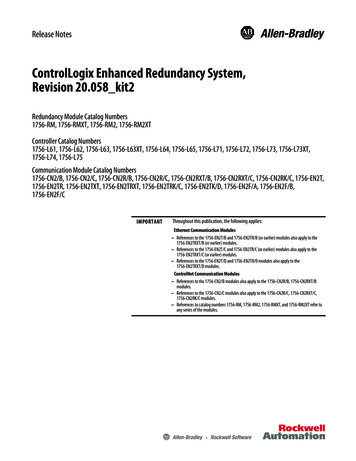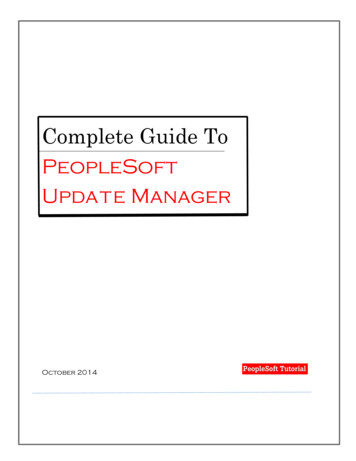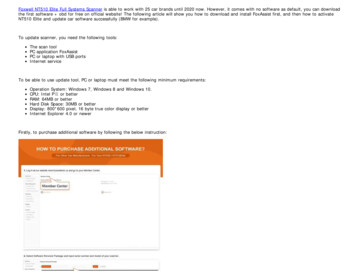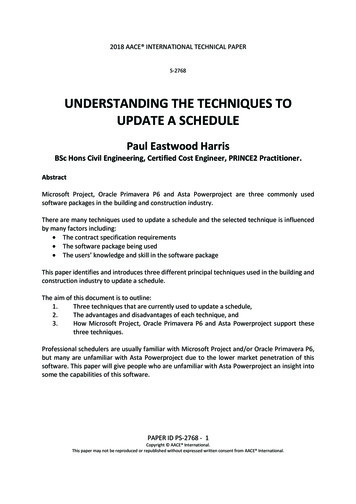
Transcription
2018 AACE INTERNATIONAL TECHNICAL PAPERS-2768UNDERSTANDING THE TECHNIQUES TOUPDATE A SCHEDULEPaul Eastwood HarrisBSc Hons Civil Engineering, Certified Cost Engineer, PRINCE2 Practitioner.AbstractMicrosoft Project, Oracle Primavera P6 and Asta Powerproject are three commonly usedsoftware packages in the building and construction industry.There are many techniques used to update a schedule and the selected technique is influencedby many factors including: The contract specification requirements The software package being used The users’ knowledge and skill in the software packageThis paper identifies and introduces three different principal techniques used in the building andconstruction industry to update a schedule.The aim of this document is to outline:1.Three techniques that are currently used to update a schedule,2.The advantages and disadvantages of each technique, and3.How Microsoft Project, Oracle Primavera P6 and Asta Powerproject support thesethree techniques.Professional schedulers are usually familiar with Microsoft Project and/or Oracle Primavera P6,but many are unfamiliar with Asta Powerproject due to the lower market penetration of thissoftware. This paper will give people who are unfamiliar with Asta Powerproject an insight intosome the capabilities of this software.PAPER ID PS-2768 - 1Copyright AACE International.This paper may not be reproduced or republished without expressed written consent from AACE International.
2018 AACE INTERNATIONAL TECHNICAL PAPERTable of ContentsAbstract . 1Table of Contents . 2Introduction . 3Aim . 4Terminology . 4Software Versions . 5Introduction to the Three Techniques for Schedule Updating . 5Un-Impacted . 5Impacted with Actuals . 6Impacted Live . 9Advantages and Disadvantages of Each Technique. 12Un-Impacted . 12Impacted with Actuals . 12Impacted Live . 13How Three Major Software Packages Handle Each Technique . 14Microsoft Project . 14Oracle Primavera P6 . 21Asta Powerproject . 26Summary of the Three Techniques . 29The Advantages and Disadvantages of Each Technique. 29How each software package supports the three techniques . 31Conclusions . 33Unimpacted Technique . 33Impacted with Actuals Technique . 33Impacted Live Technique . 33Software suitability for the Impacted with Actuals technique . 33References . 34PAPER ID PS-2768 - 2Copyright AACE International.This paper may not be reproduced or republished without expressed written consent from AACE International.
2018 AACE INTERNATIONAL TECHNICAL PAPERIntroductionThere are many project planning and scheduling software packages used in the building andconstruction industries. The most widely used in Australia and most Western World countries areMicrosoft Project and Oracle Primavera P6. Asta Powerproject is well represented in Europe andis gaining more market acceptance outside Europe.A properly updated schedule is critical to the effective management of a project and todemonstrate delays and justify claims for time extension. Often schedules are not updatedproperly with the result that time extension claims requested as the result of delays may not beadequately demonstrated or justified.There are three possible techniques that can be used to update a project schedule. AACEInternational does not identify or define official terms [1] for these techniques, so this paper willintroduce and use the following terms: Un-impacted. With this technique only the percentage complete is assigned to activitiesto denote progress, and no activity dates (start or finish) are assigned or changed duringthe update process. This technique provides the status of each activity but does notgenerate a revised end date for the project.Impacted with Actuals. With this technique actual dates are assigned in the past tocomplete activities and to the completed portions of in-progress activities. Unstartedactivities and incomplete portions of in-progress activities are scheduled into the future.New activities reflecting scope changes can be added as appropriate, and the project isscheduled to generate a revised end date. This technique conforms to AACEInternational recommended practices for statusing and updating a schedule. [2, 3]Impacted Live. With this technique, completed activities are manipulated so that theyare scheduled when they actually occurred. The following software inbuilt fields are notused: % Complete; Actual Duration; Actual Start; and Actual Finish. In-progressactivities are adjusted so they start when they actually started and will finish when theyare planned to finish, while un-started activities are scheduled into the future withscope changes added as necessary.The time interval selected to update the schedule is not addressed in this paper, but the selectionof appropriate time intervals for the schedule updates is important. When the time interval istoo long, then the impact of poor productivity or delays are not discovered early enough, andthus corrective action is taken too late to minimize any impact. The time interval should typicallybe at least 20 times over a project’s lifetime with the time interval reduced in critical times, suchas: When the start of a project has been delayed by failure to obtain approvals. It is oftendifficult to recover lost time from this day-for-day slippage. When there are significant changes of scope or method of execution. In this situation anew project schedule may be required.PAPER ID PS-2768 - 3Copyright AACE International.This paper may not be reproduced or republished without expressed written consent from AACE International.
2018 AACE INTERNATIONAL TECHNICAL PAPER When there are multiple short concurrent delays that need to be recorded for analysisand apportion of responsibility. These reduced update periods also call for use of theHalf-Step technique to analyze delays.During the testing and handover phase of a project, where unexpected equipment orprocess failures can often result in multiple schedule revisions.AimThe aim of this document is to outline: The three techniques that are used to update a schedule, The advantages and disadvantages of each technique, and How Microsoft Project, Oracle Primavera P6 and Asta Powerproject support each ofthese techniques.TerminologyEach software package and project management methodology uses different terms to identifythe date that the schedule has been updated. Some examples are: Data Date – AACE International Recommended Practice No. 10S-90, Oracle PrimaveraP6 and Phoenix and PMI PMBOK Guide 6th Edition.Status Date - Microsoft Project and Earned Value Project Management by Quentin W.Fleming and Joel M. Koppelman.Report Date – Asta Powerproject and Tilos.Time Now – Australian Standard 4817 – Project performance using Earned Value andEarned Value Management APM Guidelines.This paper will use the appropriate software term for the data date when discussing eachsoftware package and term data date when discussing scheduling principles.There are many software functions that may be employed to update a schedule. Differentsoftware packages have different functions and sometimes some functions are similar but workin a different way. For example, out of sequence progress occurs when a successor activity startsbefore the driving predecessor has finished. There are software functions that decide how out ofsequence progress is calculated. The P6 When scheduling progressed activities use function issimilar to the Microsoft Project Split in-progress tasks function and Asta Powerproject Move partcompleted links and Relink around complete tasks functions, but they all work differently.To avoid confusion over terms that may be either a software function or a project dataelement, the following formatting is used for clarity herein: All text that refers to a software function or software field is in bold print, thereforeActual Start would refer for the software field, while,Terms that refer to project data are not in bold print; therefore the term actual startwould refer to an actual start date of an activity that could be entered into an ActualStart field.PAPER ID PS-2768 - 4Copyright AACE International.This paper may not be reproduced or republished without expressed written consent from AACE International.
2018 AACE INTERNATIONAL TECHNICAL PAPERThe term “task” is used by both Microsoft Project and Asta Powerproject. The term “activity” isused by Primavera P6. The term “activity” will be used in this paper except when specificallyreferencing Microsoft Project or Asta Powerproject.Some industries and methodologies use the term “programme” and some the term “schedule”for a Gantt chart. This paper will use the term “schedule.”Software VersionsThe screenshot Figures in this paper were used using: Figures 1 to 11 were produced using Microsoft Excel 2016, Figures 12 to 25 were produced using Microsoft Project Professional 2016, Figures 26 to 33 were produced using Oracle Primavera P6 PPM Version 17 and Figures 34 to 38 were produced using Asta Powerproject Version 14.Introduction to the Three Techniques for Updating a ScheduleUn-ImpactedBefore updating the schedule, the three activities shown in Figure 1 have no progress, and asimple schedule would look like this:ActivityOrig DurDurationName% CompA10d0%B10d0%C10d0%01-AprS M T W T F08-AprSS M T W T F15-AprSS M T W T F22-AprSS M T W TF29-AprSS M T W T F06-MaySS M T W T F13-MaySS M T W T FSSFigure 1 – Unprogressd without a baseline.To update a schedule using the Un-Impacted technique: A baseline is not set or needed as the scheduled dates are not changed,The data date is identified and is displayed as a vertical line on the Gantt Chart,An activity percent complete is recorded for each activity to represent how much workhas been completed, No dates are changed as a result of this update process.After updating the schedule, the progress may be displayed against the original planned datesfor each activity, as seen in Figure 2:Activity06-May13-MayOrig Dur01-Apr08-Apr15-Apr22-Apr29-AprDurationName% Comp S M T WT F S S M T WT F S S M T WT F S S M T WT F S S M T WT F S S M T WT F S S M T WT F S SA10d90%B10d30%C10d10%Figure 2 – Progressed un-impacted schedule.PAPER ID PS-2768 - 5Copyright AACE International.This paper may not be reproduced or republished without expressed written consent from AACE International.
2018 AACE INTERNATIONAL TECHNICAL PAPERObserving Figure 2, above, we find several problems: Activity A has incomplete work displayed in the past (to the left of the data date line),which is not logical,Activity B is behind schedule with some uncompleted work (red portion of the bar)displayed in the past, which is not logical, andActivity C displays completed work in the future, which is not logical and may also affectthe scheduling of the uncompleted portion of the activity.This schedule does not inform anyone when the uncompleted work will be performed because: There is incomplete work shown in the past and people may not travel back in time tocomplete the work in the past,Nor is it possible to have completed work in the future. Consequently, this situationmakes the scheduling and projection of uncompleted work unreliable as it is affected bythe completed work displayed in the future.This schedule cannot be used to forecast of future work. Moreover, it cannot be used for delayanalysis as it does not reflect when the work was completed or demonstrate the effect of delays.Impacted with ActualsFigure 3 shows a schedule updated using this second technique, wherein: A baseline is set and is normally displayed on the Gantt Chart as a second bar for eachactivity.The data date is set and displayed as a vertical line.Completed activities: Are assigned an actual start date on the date the work actually commenced, and, Are assigned an actual finish date on the date that the work actually finished.These actual dates can differ from the baseline scheduled dates.In-progress activities: Are assigned an actual start date on the date the actual work commenced, Some software calculates the actual duration while with other software it mustbe manually entered, The remaining duration is assigned so the projected finish date is scheduled onthe date the work is expected to finish. This could be determined by theproductivity achieved to date, and A percent complete is normally assigned to each activity. There are manymethods of calculating and recording an activity progress percent complete.These include percent of duration, percent of labour hours, percent of cost orpercent of physical work completed based on the Baseline or current schedulevalues. [4]PAPER ID PS-2768 - 6Copyright AACE International.This paper may not be reproduced or republished without expressed written consent from AACE International.
2018 AACE INTERNATIONAL TECHNICAL PAPER ActivityNameUn-started and incomplete portions of in-progress activities may have their remainingdurations adjusted by applying actual productivity rates achieved to date from similarcompleted work.Activities reflecting scope changes or delays may be added.Multiple splits (suspension and resumption of work) may be assigned in somescheduling software. Software that does not support multiple splits may have thesemodelled by the creation of multiple activities or by assigning a specific calendar to theactivity to model the splits.Original Orig ion % Comp S M T WT F S S M T WT F S S M T WT F S S M T WT F S S M T WT F S S M T WT F S S M T WT F S SA10d100%B10d30%C10d0%Figure 3 – Impacted with Actuals with splits.In addition, scope changes may be represented by adding or deleting activities as seen in 06-May13-MayOriginal Orig DurDuration % Comp S M T WT F S S M T WT F S S M T WT F S S M T WT F S S M T WT F S S M T WT F S S M T WT F S SA10d100%B10d30%ScopeChange2d0%C10d0%Figure 4 - Impacted with Actuals with a scope change activity.This technique: Conforms to AACE International recommended practices for updating schedules,Results in software being used in the way most software is designed to be used,Records when activities actually started and actually finished, which is essential forhistorical records and claims assessment,Re-forecasts when incomplete or in-progress activities will take place, so it may be usedto manage the project, andDemonstrates impacts to the schedule resulting from delays and changes in productivity.Out of sequence progress occurs when a successor activity starts before the driving predecessoractivity with a Finish to Start relationship has finished. Most software has options whichdetermine how the remaining portion of a successor activity is calculated when it hascommenced before its predecessor is complete.In Figure 5, below, the schedule has been updated where the “out of sequence logic” has beenacknowledged in the CPM calculations:PAPER ID PS-2768 - 7Copyright AACE International.This paper may not be reproduced or republished without expressed written consent from AACE International.
2018 AACE INTERNATIONAL TECHNICAL PAPER The Primavera Retained Logic option or the Microsoft Project Split In-progress option orthe Asta Powerproject Move part completed links has been used, andThese options split the activities to allow the remaining portion of in-progress activitiesto acknowledge the predecessor Finish to Start relationship:Activity Original Orig Dur01-Apr08-Apr15-Apr22-Apr29-Apr06-May13-MayName Duration % Comp S M T WT F S S M T WT F S S M T WT F S S M T WT F S S M T WT F S S M T WT F S S M T WT F S SA10d90%B10d30%C10d10%Figure 5 - Impacted with Actuals and out of sequence logic acknowledged.Note that Figure 5 shows an interrupted period (gap) before work on the remaining portion ofActivity B resumes, driven by the remaining duration of the predecessor Activity A.In Figures 6, 7 & 8 below the schedule has been updated with “out of sequence logic” that isnot acknowledged in the CPM calculations: In Figure 6, the Primavera Progress Override scheduling option has been used; theMicrosoft Project Split In-progress option and the Asta Powerproject Move partcompleted links have not been used; The predecessor Finish to Start relationship is ignored and; The result is a less conservative schedule forecast, as the successor activities have notbeen split.Activity Original Orig Dur01-Apr08-Apr15-Apr22-Apr29-Apr06-May13-MayName Duration % Comp S M T WT F S S M T WT F S S M T WT F S S M T WT F S S M T WT F S S M T WT F S S M T WT F S SA10d90%B10d30%C10d10%Figure 6 - Impacted with Actuals and out of sequence logic not being acknowledged.Figure 6 shows Activities A, B & C with far greater concurrency than originally planned. This is areason why many owners forbid the use of the Progress Override scheduling option. To overcome the issue of a shorter duration schedule which invariably results from theincreased, unplanned concurrency, the remaining durations may be extended so that theend dates of in-progress activities calculate with the same end date as the schedule withthe out of sequence option turned on, a
Apr 16, 2018 · There are many project planning and scheduling software packages used in the building and construction industries. The most widely used in Australia and most Western World countries are Microsoft Project and Oracle Primavera P6. Asta Powerproject is well represented in Eur


